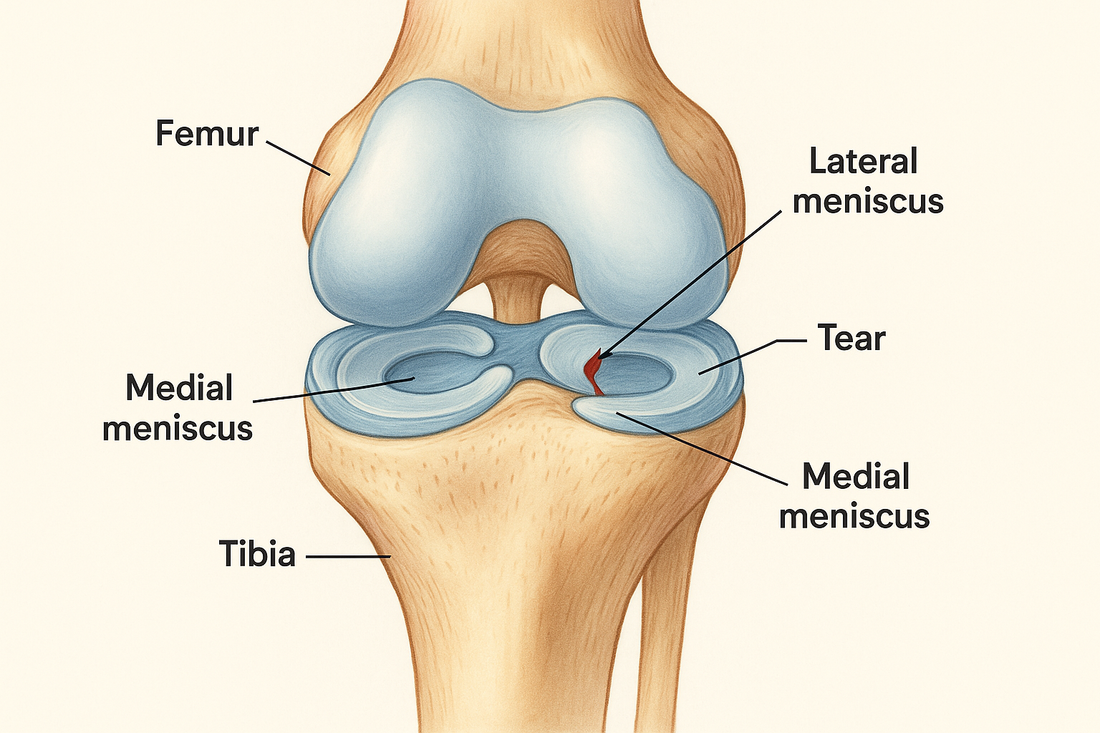
Understanding Meniscus Tears: A Health Guide to Symptoms, Precautions, and Relief
Share
A meniscus tear is a common knee injury that can happen to anyone, from athletes to individuals going about their daily routines. The menisci are two C-shaped pieces of cartilage that act as cushions between your shinbone (tibia) and your thighbone (femur). They help stabilize your knee and absorb shock. When one of these cartilages tears, it can lead to a range of uncomfortable symptoms.
It's important to recognize the signs of a meniscus tear and understand how to manage them to prevent further complications and promote healing. In this guide, we'll delve into the typical symptoms, discuss important precautions, and highlight how you can find relief.
Recognizing the Symptoms of a Meniscus Tear

The symptoms of a meniscus tear can vary depending on the size and location of the tear, as well as other individual factors. You might experience:
-
Pain: This is often felt along the joint line of the knee. The pain may be sharp initially and then become more of a dull ache.
-
Swelling: Inflammation around the knee joint is common and can develop gradually over a day or two after the injury.
-
Stiffness: Your knee might feel stiff, making it difficult to fully bend or straighten your leg.
-
Popping Sensation: You might hear or feel a "pop" in your knee at the time of the injury.
-
Locking or Catching: Your knee may feel like it's catching, locking, or getting stuck, making it hard to move.
-
Giving Way: You might experience a sensation of your knee "giving way" or feeling unstable, especially during certain movements.
-
Limited Range of Motion: You may not be able to bend or straighten your knee fully.
It's interesting to note that you may also experience some symptoms around the patella (kneecap) as a result of altered biomechanics or referred pain due to the meniscus tear. This can manifest as discomfort or tenderness around the front of the knee.
The Critical Risk of Infection

While the initial symptoms of a meniscus tear are primarily pain, swelling, and mechanical issues, one of the most effective (and concerning) symptoms to be aware of is infection. Although not a direct symptom of the tear itself, infection can occur if the injury requires surgery or if an open wound is present.
You should take serious precautions against the risk of infection. Signs of a knee infection can include:
-
Increased redness and warmth around the knee.
-
Worsening pain and swelling.
-
Fever and chills.
-
Pus or drainage from any wound.
If you experience any of these signs, it's crucial to seek immediate medical attention as infections can be serious and require prompt treatment.
Preventing Worsening Symptoms and Promoting Healing

If you want to prevent these symptoms from worsening and support the healing process of a meniscus tear, consider the following:
-
R.I.C.E. Protocol: Follow the R.I.C.E. protocol (Rest, Ice, Compression, Elevation) in the initial days after injury.
-
Rest: Avoid activities that aggravate your knee pain.
-
Ice: Apply ice packs for 15-20 minutes several times a day to reduce swelling and pain.
-
Compression: Use a compression bandage to help control swelling.
-
Elevation: Keep your leg elevated above your heart as often as possible.
-

-
Pain Management: Over-the-counter pain relievers like ibuprofen or naproxen can help manage pain and inflammation. Consult your doctor about appropriate medication.
-
Gentle Movement: Once the initial pain and swelling subside, your doctor or physical therapist may recommend gentle exercises to maintain range of motion and strength.
-
Physical Therapy: A physical therapist can design a tailored exercise program to strengthen the muscles around your knee, improve stability, and help you regain full function.
-
Avoid Aggravating Activities: Identify and avoid activities that worsen your knee pain or cause it to swell or feel unstable.
-
Consider Assistive Devices: If needed, using crutches can help offload weight from the injured knee, promoting healing.
-
Maintain Hygiene: If you have any wounds, keep them clean and covered to prevent infection. Follow your doctor's instructions for wound care after any surgical procedures.

Benefits of Nevilife Meniscal Tear Cream may include:
-
Soothing Discomfort: The cream may help to alleviate pain and tenderness around the knee joint.
-
Reducing Inflammation: Natural ingredients can assist in calming inflammation and swelling.
-
Promoting Circulation: Improved blood flow to the area can support the body's natural healing processes.
-
Easy Topical Application: The cream can be applied directly to the knee for targeted relief without systemic side effects.
Incorporating Nevilife Meniscal Tear Cream into your self-care routine, alongside other recommended treatments and precautions, may offer a natural way to enhance your comfort and support your journey towards recovery from a meniscus tear. Remember to always consult with your healthcare professional for a proper diagnosis and comprehensive treatment plan.
Disclaimer: This blog post provides general information and should not be considered medical advice. Always consult with a qualified healthcare professional for diagnosis and treatment of any medical conditions. The information about Nevilife Meniscal Tear Cream is for informational purposes and does not claim to cure or treat meniscus tears.
Relevant Hashtags:
#PhysicalTherapy #RICEProtocol #Nevilife #NaturalRelief #MeniscalTearCream #KneeSupport #InjuryRecovery #ActiveRecovery #PreventInfection